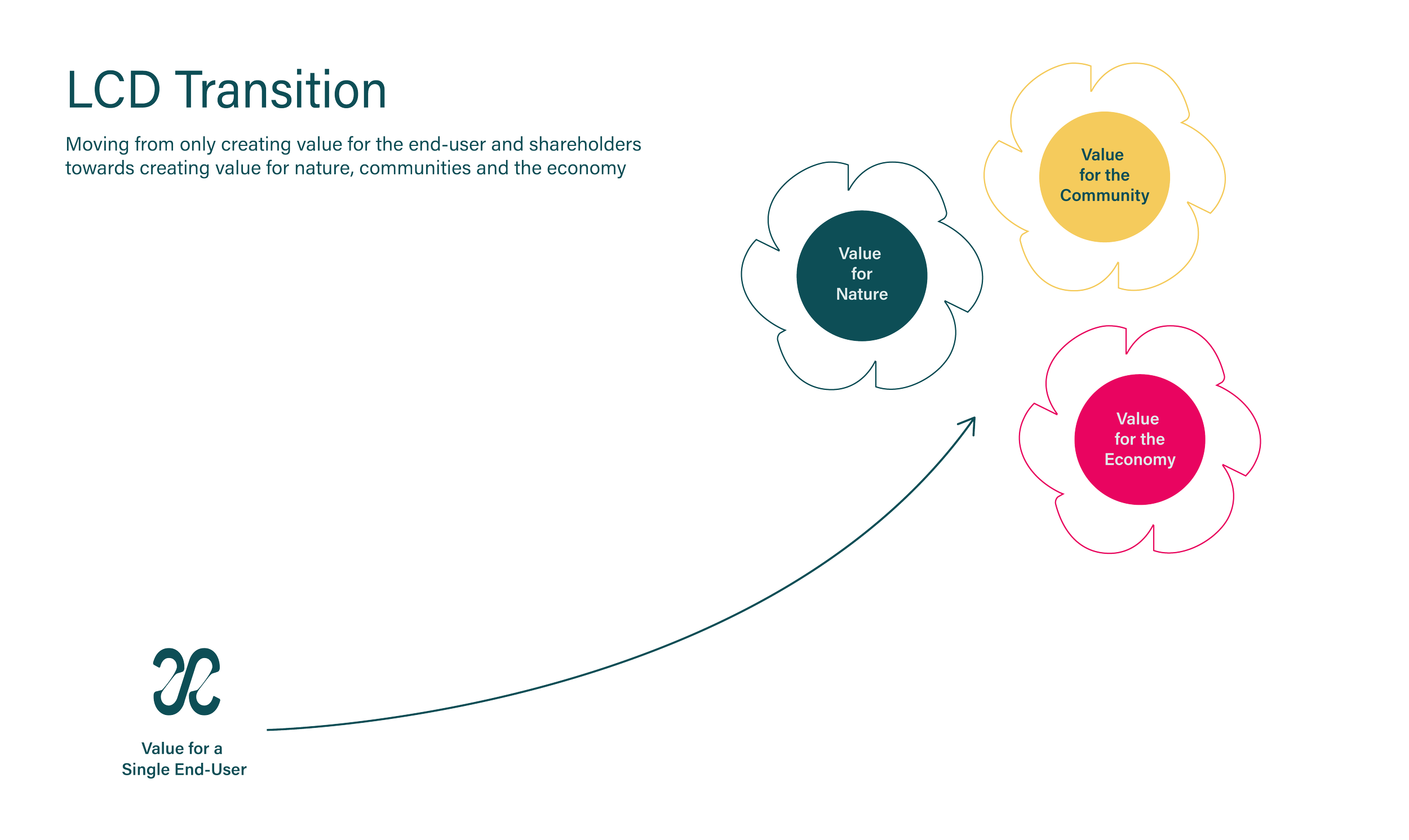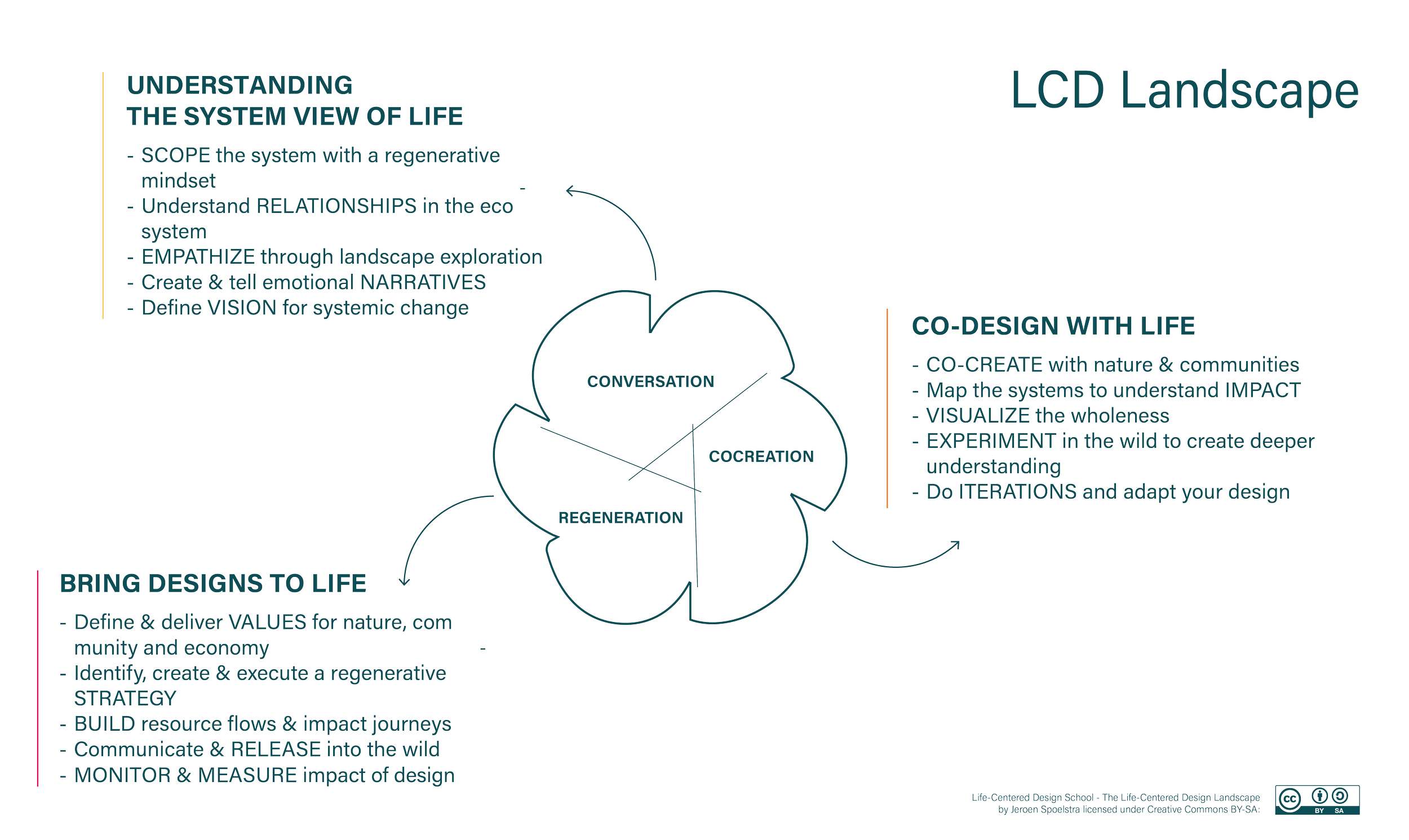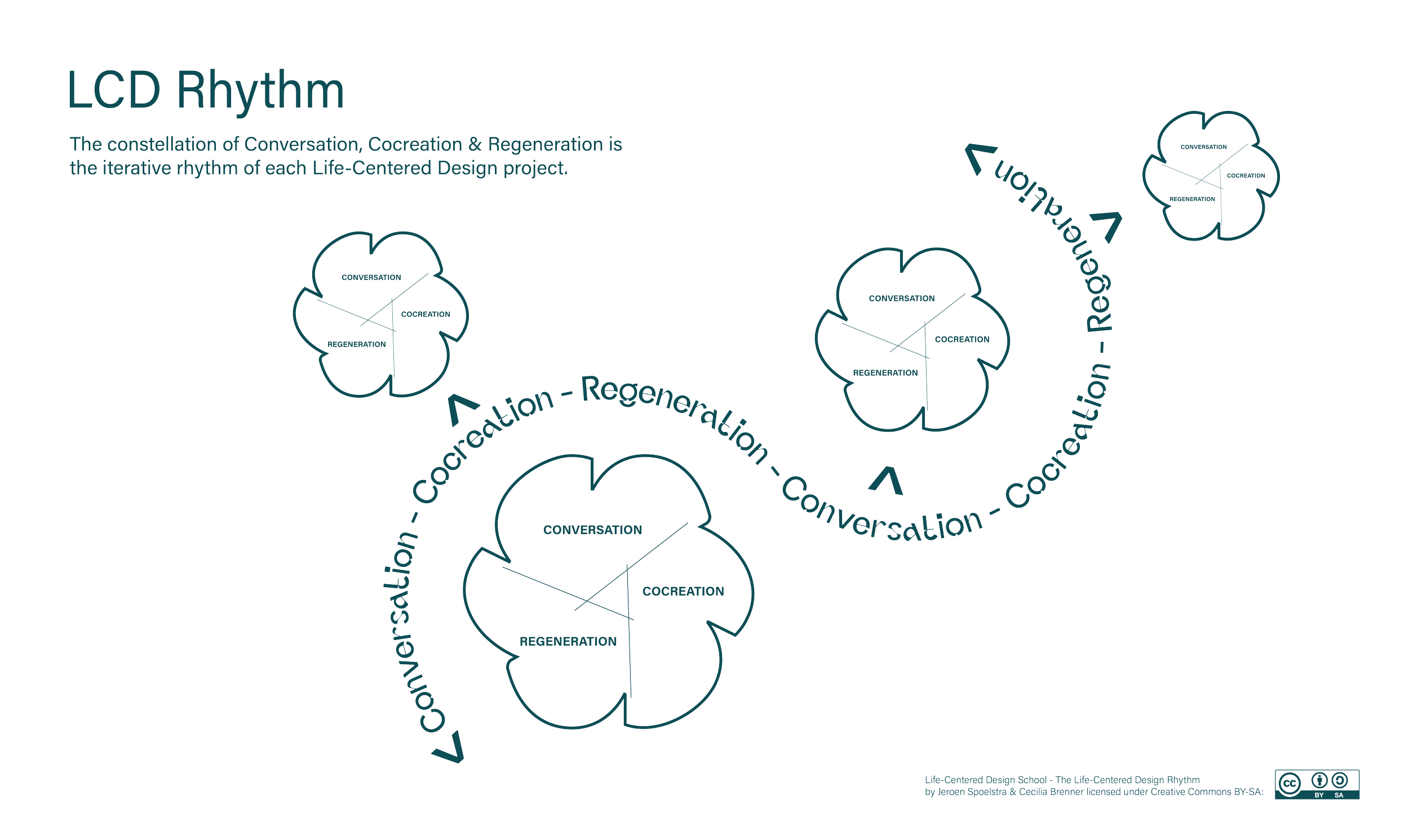What is Life-Centered Design?
This has been a big question for me. I've been trying to find an answer since I discovered Life-Centered Design in September 2020. In a blog post I wrote in early 2022, I used this definition
“LCD is a design philosophy and approach that goes beyond human needs and puts all life at the centre of our creations. LCD advocates for biological ecosystems and non-user communities that have never had a voice in the design process. The long-term goal is to restore natural ecosystems by creating new relationships between nature and society.”
You can find similar definitions from some of my design friends, such as Damien Lutz, Martin Tomitsch & Katharina Clasen, but what does this actually mean, and what does this entail for the designer and the design profession? What if we design for a world that considers all forms of life? How could that world look like? What could design do? I started asking these questions three years ago.
Wondering in nature with my son
Today I share some new answers. Life-Centered Design is more prosperous than that initial definition. Since then, I have talked with over 100 designers, biologists, anthropologists, and BIPOC, worked on life-centred projects and started the LCD School. Learning from working on projects and collaborating with participants worldwide, the idea of Life-Centered Design evolved.
What is Life-Centered Design?
Creating value for all life forms
Life-Centered Design is an actionable design approach that gives designers and other creatives the mindset, opportunity and ability to design holistically. It allows designers to include all life forms and advocates for biological ecosystems and non-user communities. LCD moves away from creating value for the end user & shareholders towards adding value for nature, communities and the economy.
Include nature & communities.
Traditionally, we have learned to design for humans, specifically for an end-user. Adding a holistic lens to design, stretches the concept of the user or use. Can nature also be a user of design? LCD includes a nature point of view, giving species, habitats & ecosystems a voice in the design practice. Empathizing with life on earth doesn't solely come from scientific research and immersive excursions in nature, but these need to come from the wisdom of the indigenous communities worldwide. As a designer, there is still much to learn from these communities. Life-Centered Design shifts our minds from designing solely for the privileged white to creating with the pluriverse communities worldwide.
In her book Decolonizing Design, Dori Tunstall describes how our global design profession is based on the early Bauhaus principles, originating from a white Northern European male point of view. Which is precisely what I am. I learned from Tustall to widen my view, open my Bauhaus values and include values and principles from BIPOC, LGBTIQA+ Females and other underrepresented communities. I get challenged daily to let GO of old beliefs and embrace new ones. And that is a good thing! Life-Centered Design gives space to all these underrepresented communities and has them lead the conversation.
I constantly try to have an eye open for the privileged choices I make that are deeply engraved in my subconscious. In the Impact Policy AU podcast, Sam Alderton-Johnson & Nellie Pollard-Wharton explain well how although First Nations have been able to study and find better jobs, the power of decision-making about funds and legislation for First Nation people is still in white hands.
Life-Centered Design let's go of the end-user focus. When we design something, we ask ourselves what the impact is on nature, underrepresented communities and the user/ business and how we integrate that into a pathway forward that benefits all. Whose life do we design for, and what are we solving, for whom? You will hardly ever come up with one solution when you work with several points of view, with each their own challenges.
The Design Framework
Life-Centered Design Landscape
Over the last couple of years, I experimented with different methods, processes & principles, and my conclusion is that if LCD focuses too much on tools within step-by-step processes, much will remain the same compared to today's Human-Centered Design or User Experience Design practices. Instead, we think of it as a Life-Centered Design Landscape where you move between spaces in a certain rhythm and pace. This is how you apply life-centered design to a project or question.
Three Spaces
We identify three spaces in the landscape. You can start in either of these spaces depending on the needs of the project and the expertise of the team you are working with.
Understanding the Systems View of Life is the conversation space in which you know & establish relationships with the living system. The living system includes nature, people, and organizations. We assess the health of the system and identify areas for improvement, approaching it with a regenerative mindset.
According to Josie Warden, having a 'regenerative' mindset means seeing the world as built around reciprocal and co-evolutionary relationships, where humans, other living beings and ecosystems rely on one another for health and shape (and are shaped by) their connections with one another. It recognizes that addressing the interconnected social and environmental challenges we face is dependent on rebalancing and restoring these relationships.
A key element is empathizing with the system through landscape exploration, scientific research and imagination. Through scientific research, you can understand the biological, geological and anthropogenic health of actants in the ecosystem. Still, exploration, immersion and observation give you a deeper sensory understanding and allow you to empathize. Imagination and creativity will enable you to make & tell emotional narratives from the different actants, leading to defining a vision for systemic change.
Co-Design with Life is the cocreation space where we co-create and prototype life-centered pathways with nature & communities. Ingrid Burckett defines co-design as: "collaborating, including and designing WITH people that will use, deliver or engage with a service or product."
However, this definition does not include the planet while nature also delivers and engages with services, products & organizations and is often impacted by its use.
You can include nature in the co-design space by giving nature a voice. A representative of species, habitats or ecosystems, such as scientists or NGOs, can give that voice. Or you can create non-human personas and include them in the co-design practice. You must first create ethical principles when using non-human personas in the design space. This way, we make sure nature really benefits. When we integrate nature, communities and the economy, we can create whole life-centred pathways.
Solutions or strategies are only sustainable & regenerative when we test the assumptions to understand our impact. We must experiment in the wild and prototype our design with nature & communities. We must iterate and adapt our design until we have our desired impact.
Bring Designs to Life is the regeneration space of Life-Centered Design, where you define and deliver values for nature, community and economy. You need to understand what success is meant for your project and how to measure this. How does the business and/ or value model for your life-centered innovation look? Are you going for a social enterprise model and spreading your innovation? Will it be a circular business model, or are you giving your model away for free? And how does nature play a role in your business model? For example, British shampoo brand Faith in Nature made added nature to their board of directors.
Your innovation needs to live. Learn from nature how to do this and be responsive to changes & adaptation. Identify, create and execute a regenerative strategy with positive learning loops, where the value for each element positively influences the other aspects of the system. It describes how you release your innovation in the wild and how to communicate this. The regenerative strategy includes resource flows and impact journeys with ways to monitor and measure impact.
Where to start?
I have practised with different starting points, and most work great. We had a participant in one of our courses who designed a life-centered brand identity for a communal garden in Vermont, which is a very concrete graphic design starting point. I have been asked to identify a systemic problem that a B2B service system can solve. We have taken the Bearded Vulture as our client in our retreats, which allowed for an open starting point for the project. Some designers start with a closed question, such as how can we change the material of the credit cards, and by going through the LCD spaces, they eventually create a co-design session for bank employees about Educating Climate Friendly Banking.
When you start with a value or business question, you will likely begin in the Regeneration space. If you start open with the idea of understanding a systemic problem, you will begin at the Conversation space. If you have a concrete design idea, you start exploring the Integration space.
The starting point depends on time, space, intent, expertise and resources available.
The Quebrantahuesos also known as the bearded vulture
The Design Mindset
The Life-Centered Design Landscape is the context you work in with all its elements. The purpose of the landscape and its individual space help you create the condition to design in a way that benefits nature, communities and the economy.
Rhythm
In the LCD landscape Conversation, Cocreation and Regeneration each have their own space. These terms are also the lenses you go through a project as a whole, its individual elements and actions. See the constellation of these words as the iterative rhythm of each Life-Centered Design project. Like IDEO uses Desirable, Feasible & Viable, we use Conversation, Cocreation and Regeneration. This is the intention with which we design.
Pace
In recent years design has been about sprinting, agility, leanness and efficiency. We need to innovate fast for quick business results. The pace of Life-Centered Design is slower, and it asks us designers to be more mindful of the various ecosystems involved in our work and projects.
This encourages us to create in new and innovative ways, with nature at the core. This results in a slower way of designing. Our SLOW framework helps you find the right pace. It goes like this:
Start Differently : To change things up when beginning a project, try doing the opposite of what you usually do. For instance, instead of starting with a scrum or brainstorming session, try going outside and beginning with a design walk or a storytelling exercise.
Learn to be uncomfortable: Just like the familiar "comfort zone" image, venturing outside your safe space may not be pleasant initially, but it can bring surprising results. It requires courage and motivation to embrace discomfort.
Observe the ecosystem: Merely seeing something does not equate to observing it. Observation requires a mental process that involves both visual perception and thinking.
Wait with decision-making: Postpone decision-making to allow insights and ideas to flourish. The best ideas don't happen in a 2-hour design sprint. At best, you can plant the seed of a good idea. After that, you need your subconscious and conversations to do their job.
In a previous blog, we explain why we should slow down design, and in this guide, you will find the framework explained with exercises.
Writing this article makes me realize how far we have come with Life-Centered Design since I discovered its existence in 2020. It also makes me realize how far we still have to go because we are just beginning to create a design profession that is good for all life on this planet, not just human life. I want to thank everyone that has helped me on this life-centered design journey so far, and this is not a one-designer adventure.
My mission is to teach this approach to as many designers as needed to make them shift from Human-Centered Design to Life-Centered Design. That is why we created the LCD School, where we allow professionals to experience Life-Centered Design first-hand and then have the knowledge to apply it in their work environments. As a seed, we started small, but as a tree, we keep growing!
Author: Jeroen Spoelstra
Images: Jeroen Spoelstra








